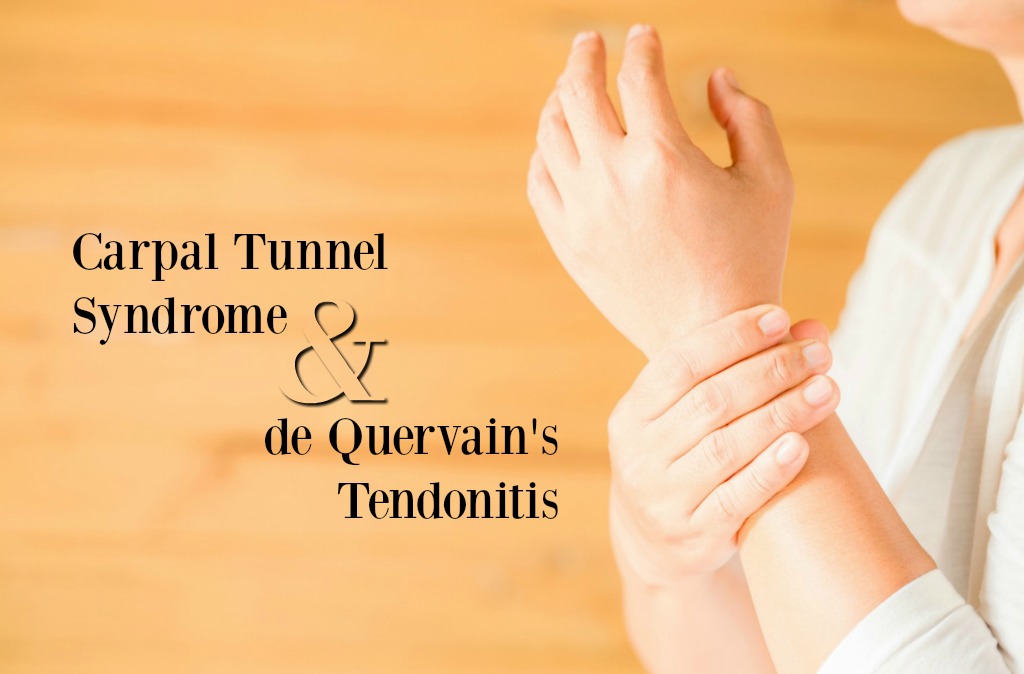Carpal Tunnel Syndrome (CTS) and de Quervain’s Syndrome are both thumb-fingers-palm-hand-wrist to forearm pain in one or both hands due to inflammation in the carpal tunnel and/or the tendons of the thumb. The result is pain in the hands.
Both men and women can get both conditions but women suffer from CTS three times more than men according to this study.
In the case of de Quervain’s tendinosis or tendonitis, women suffer from the syndrome eight to 10 times more than men, says the Cleveland Clinic.
Experts can’t say exactly why women suffer from these painful conditions more than men but suggest that hormonal changes that cause fluid retention, especially during pregnancy or menopause, may be the reason.
CTS occurs in 31% to 62% of pregnant women, estimates this study. Sometimes, pregnant women can suffer from both CTS and de Quervain’s at the same time and resolving the condition may not take place many months after the baby is born. This makes childcare difficult. In one study, only one out of six women who had CTS during pregnancy still had symptoms 12 months after delivery. This means that after some time, usually after breastfeeding, the pain does go away in the end for the majority of women.
Find out more about CTS and de Quervain’s Syndrome here.
How to Safely Home-Treat Hand Pain during Pregnancy
Before you begin treating your hand, here is one very important measure you need to take to prevent CTS and de Quervain’s Tendonitis:
Do not gain excessive weight during pregnancy. Do not be overweight before you become pregnant and then gain some more weight as you go along as this predisposes you to getting CTS and de Quervain’s Tendonitis.
However, oedema and swelling during pregnancy cannot be helped especially if you are expecting more than one baby or if your breasts become very large. This will put extra strain on your shoulders, ribs and arms. Nerves in these areas travel down to your hands and may make you prone to CTS and de Quervain’s Tendonitis.
In treating both these conditions, the same methods can be used as they are both about nerve compression and tendon inflammation. You could try the following baby-safe methods to give yourself some relief when the pain or numbness become extreme.
1. Acupuncture
Acupuncture is said to relieve your painful hands. In fact, this study published in NCCAOM says acupuncture is an effective treatment modality for CTS and can restore dexterity. It even suggests that it reduces pain more than splinting your hands at night.
2. Exercise
Gently stretch your hands and arms. Try not to do any movements that are painful, as some stretches can make your hand pain worse.
3. Use a splint
This is to keep you from bending your wrist. Sleep with the splint to prevent you bending your wrists or curling your fingers and hand when you are asleep.
4. Massage
Clasp one wrist with your other hand and massage it with a circular movement. This may ease congestion and encourage the movement of fluid.
You can ask your husband to gently massage your hands and wrists, moving up towards your armpits, and then your shoulders, neck and upper back.
5. Lift baby differently
Instead of picking baby up under his arms, try to scoop him up by the buttocks instead. This will remove the strain on your thumbs.
6. Use cold therapy
Apply ice wrapped in a towel to your wrist for about 10 minutes, several times a day, to help decrease swelling. You can also try a “contrast bath”. Soak your wrist in cold water for about one minute, then in warm water for another minute. Keep alternating several times to encourage circulation.
7. Elevate your hands
You can use pillows or cushions to do so.
8. Rest the hand
When you feel pain or fatigue in your wrist, stop that activity, switch to another activity or rest it for a while. De Quervain’s Tendonitis is caused by repetitive movement, such as typing on a keyboard.
9. Drink Water
Staying hydrated is important for general health. The point is to keep your overall health in good condition so that you can better handle the stresses and strains of coping with taking care of a baby and hand pain.
10. Take Paracetemol
Ask your doctor for advice when taking over-the-counter medication or ask him to prescribe.
11. Change positions to breastfeed
Mimimise usage of your wrist to hold baby’s head when breastfeeding. Instead, experiment with different positions like lying on your side or have baby in a football hold. Or use pillows and blankets to prop, support, or brace when needed.
For more stories on pregnancy and related issues, check back on Motherhood.com.my.
